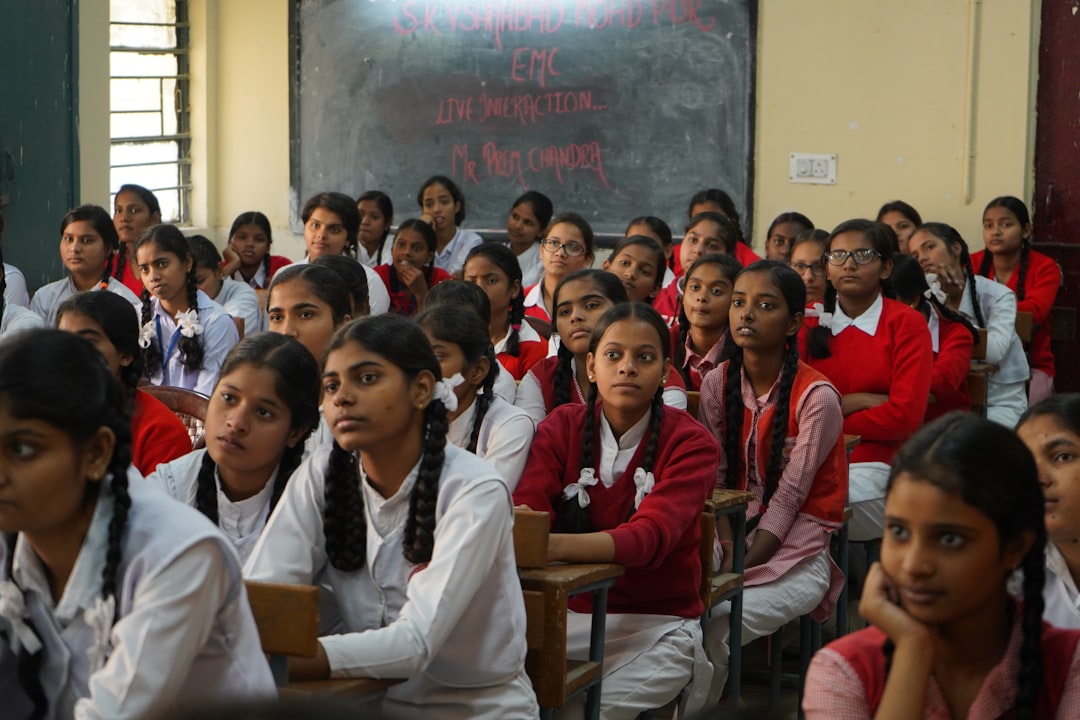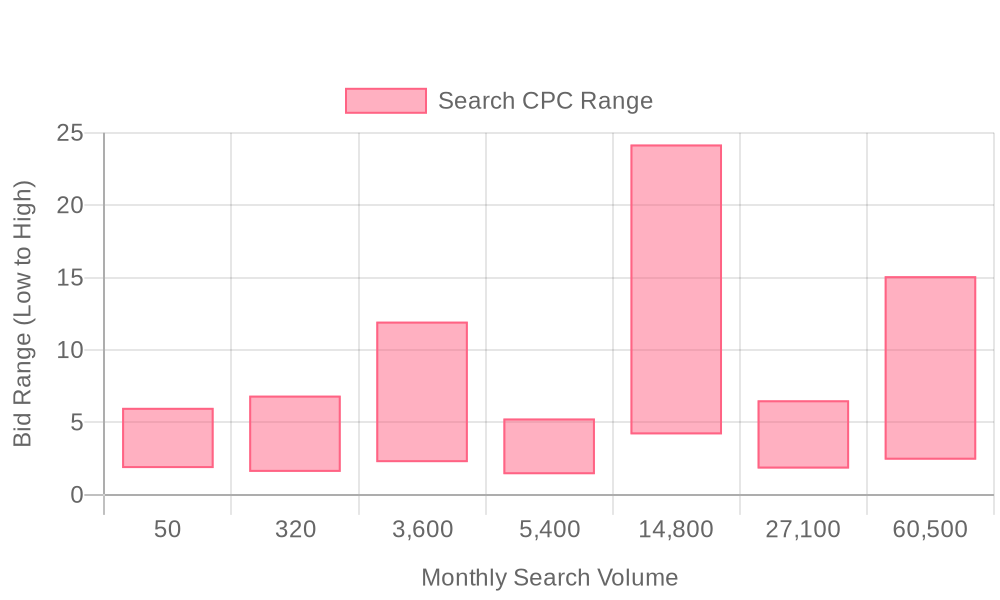
Supercharge your lead generation with a FREE Google Ads audit - no strings attached! See how you can generate more and higher quality leads
Get My Free Google Ads AuditFree consultation

No commitment
Supercharge your lead generation with a FREE Google Ads audit - no strings attached! See how you can generate more and higher quality leads
Get My Free Google Ads AuditFree consultation

No commitment
Secondary schools face increasing competition to attract prospective students and their parents. In this digital era, leveraging Google Ads can significantly enhance a school's visibility online. However, navigating digital marketing for schools, especially with tools like Google Ads, can be challenging. Secondary schools often struggle with generalized campaigns that lead to poor engagement and wasted budgets. Disconnected intent signals also pose challenges, making it difficult to tailor outreach effectively. This guide aims to demystify Google Ads for education providers, offering actionable strategies to not only bolster your school's online presence but also to address these prevalent pain points and attract more enrollments.

Effective lead generation for secondary schools demands more than generic online advertising. Modern families and decision-makers expect personalized experiences, clear value propositions, and seamless digital interactions throughout their research and enrollment journey. For schools seeking to identify and prioritize anonymous website visitors who may be considering enrollment, leveraging Sona Identification can turn passive site traffic into qualified leads.
A data-driven Google Ads strategy tailored to secondary education empowers schools to reach high-intent audiences, highlight their unique offerings, and optimize every dollar of ad spend. This guide breaks down the essential steps to maximize new student inquiries and open day registrations—while maintaining brand integrity and measurable performance. For a deeper dive into Google Ads for schools, explore actionable tips for schools to maximize marketing results.
By following these steps, secondary schools can maximize their visibility and efficiency in lead generation, ensuring campaigns are relevant and engaging for every prospective family. If you're ready to streamline your student recruitment efforts, get started for free with Sona.

Secondary schools face increasingly complex marketing challenges as families rely on digital research to inform their education choices. Google Ads gives schools the power to connect with high-intent audiences at the moment they search for programs, location, or educational values that match their goals. By leveraging advanced targeting capabilities, secondary schools ensure their message reaches parents and students who are actively evaluating school options in the right geographic and demographic segments. For a deeper look at how educational institutions can leverage Google Ads to attract more students, see how Google Ads benefits schools.
Specific audience targeting in Google Ads allows schools to filter for parents of teens, families in defined districts, or those searching for specialized programs. Bid adjustments and real-time demographic controls let schools allocate more budget to zip codes or audience groups proven to generate quality inquiries. With dynamic updates, marketers can track which audience segments are progressing through the funnel and adjust creative or bids to match their evolving intent. Explore our step-by-step guides for optimizing your school’s marketing, sales, and lead generation workflows.
Data-driven insights transform what was once anonymous website traffic into actionable intelligence. Using modern visitor identification and intent analysis, marketing teams can pinpoint which companies and households are engaging with their content and prioritize outreach. As soon as a prospective family moves from initial interest to high-conversion behavior, revenue teams can shift spend or trigger follow-up, ensuring no high-value lead is left behind.
The integration of online and offline conversion tracking reveals the true ROI of every campaign. By syncing Google Ads audiences and leads directly into CRM systems, schools gain a unified, real-time view of engagement across all channels. This closed-loop clarity eliminates guesswork, enabling secondary schools to refine their digital marketing for schools strategy and systematically increase enrollment at a lower cost per acquisition.

Ready to maximize your school's Google Ads performance? Get started for free with Sona.

Secondary schools committed to enrollment growth need to move well beyond generic digital marketing tactics. The most successful teams blend precise targeting, dynamic data integration, and ongoing competitive intelligence to uncover untapped segments and drive higher-quality inquiries. Leveraging real-time audience insights enables marketers to spot emerging segments and tailor outreach as new student interests develop.
Ready to align every digital touchpoint with the changing needs of prospective families? Get started for free with Sona.

Audience segmentation is essential for schools aiming to maximize the efficiency and impact of their Google Ads campaigns. Segmentation allows marketing teams to split large audiences into meaningful groups based on unique characteristics, ensuring every interaction is relevant and personalized. This approach not only reduces wasted spend but also increases the likelihood of connecting with families actively seeking educational opportunities. For an overview of how schools can leverage Google Ads to attract more students, see Google Ads for education.

| Industry | Keyword | Monthly Search Volume | Competition Level | Low Bid | High Bid |
| Secondary Schools | private secondary schools near me | 50 | LOW | 1.85 | 6.01 |
| Secondary Schools | secondary schools near me | 320 | LOW | 1.59 | 6.85 |
| Secondary Schools | alternative high schools near me | 3600 | LOW | 2.26 | 11.96 |
| Secondary Schools | christian high schools near me | 5400 | LOW | 1.43 | 5.27 |
| Secondary Schools | secondary education | 14800 | LOW | 4.18 | 24.19 |
| Secondary Schools | private high schools near me | 27100 | LOW | 1.82 | 6.53 |
| Secondary Schools | secondary schools | 60500 | LOW | 2.43 | 15.1 |
Effective keyword strategy is the foundation of high-performing Google Ads for Secondary Schools campaigns. To capture families at every stage of the enrollment journey, schools must balance broad, high-volume keywords with niche, intent-driven terms that reflect specific academic interests, extracurricular programs, and location-based needs. This approach ensures campaigns engage both active searchers comparing local schools and those exploring specialized offerings, such as STEM programs or international baccalaureate curricula. For actionable guidance on maximizing keyword impact, see this overview of Google Ads for education.
A comprehensive keyword portfolio should include general discovery terms like "secondary schools near me," as well as targeted queries such as "best private high schools in [city]," "boarding school open days," and "college prep schools with robotics." Incorporating negative keywords—such as "elementary," "free," or "job openings"—prevents wasted spend on irrelevant traffic. By using search term reports and analyzing intent signals, marketers can quickly identify high-converting queries and expand into emerging areas where demand is shifting.
Revenue-driven teams benefit from platforms that connect keyword performance with downstream enrollment outcomes. For instance, when a parent searches "enroll in STEM-focused secondary school," real-time visitor identification uncovers whether that interest aligns with previously engaged website visitors. Dynamic audience segmentation ensures that as a family progresses from research to inquiry or application, they receive increasingly personalized ad experiences. By syncing enriched audience data and lead activity directly into downstream systems, marketing and admissions teams see not just which keywords drive clicks, but which ones move prospective students through the entire journey—from first touch to enrollment.
Schools that regularly audit and refine their keyword lists, leveraging both quantitative metrics and behavioral insights, consistently outperform those relying on static, generic terms. This ongoing optimization is essential for maximizing the impact of Google Ads campaigns for education, lowering cost per inquiry, and driving measurable enrollment growth. To see how your school can apply these strategies, get started for free with Sona.
A structured approach is essential for schools aiming to maximize the value of Google Ads for Secondary Schools. Each step in this execution framework addresses a critical stage in the campaign lifecycle, reducing wasted spend and improving both lead quality and conversion rates. By operationalizing data at every turn, secondary schools can reach more qualified families, drive event registrations, and accelerate enrollment pipelines.
Identifying the right keywords establishes the foundation for every successful Google Ads campaign. Schools should prioritize terms closely tied to academic offerings, extracurricular programs, and local or regional intent—such as “private STEM high school in [city],” “boarding schools with scholarships,” or “open day registration for [school name].” For a deeper dive into maximizing keyword relevance and campaign results, review these actionable tips for schools. Including modifiers that reflect parent concerns or student aspirations narrows the audience to those most likely to convert. Negative keywords are equally important for filtering out searches unrelated to admissions or education, protecting budgets from low-value traffic.
When audience data is unified and enriched, keyword development becomes far more precise. For example, connecting CRM insights to search intent allows marketers to identify which academic programs or open days drive the most interest among high-fit prospects. This enables more granular keyword targeting, ensuring ad spend focuses on in-market families and high-potential localities.
Ad creative must resonate with both parents and students, emphasizing what sets the school apart in a crowded educational landscape. Headlines that call out student achievements, college acceptance rates, or unique extracurriculars catch attention early. Supporting copy should reinforce trust, highlight community culture, and prompt immediate action—like booking a tour or downloading a prospectus. Responsive search ads allow schools to test multiple value propositions and calls-to-action, letting the platform optimize delivery based on real-time engagement data.
Real-time visitor identification elevates ad messaging by surfacing which themes or attributes are most compelling to each audience segment. Marketers can then dynamically adjust creative to reflect the latest in-market behaviors, tailoring offers for families researching specific programs or responding to seasonal enrollment cycles. This data-driven customization consistently improves click-through and conversion rates.
Every click should lead to a landing page that is tightly aligned with the ad’s promise, visually engaging, and optimized for mobile experiences. Essential elements include a clear headline, succinct program details, authentic testimonials, and a frictionless inquiry or registration form. Trust signals—such as accreditation badges or recent rankings—reinforce credibility. The landing page should focus on a single conversion goal, minimizing distractions and guiding visitors toward completing a form or scheduling a visit.
Integrating online and offline conversion tracking provides a holistic view of which landing pages and creative elements are driving true ROI. For a look at best practices for tracking conversions, see Google Ads best practices. By syncing CRM data with Google Ads, schools can attribute enrollments or open day registrations to the originating campaign, ad group, and even keyword. This closed-loop measurement supports continual landing page optimization, ensuring every touchpoint contributes to enrollment growth.
Continuous campaign refinement is the hallmark of effective digital marketing for schools. Conversion data should inform automated bidding strategies, budget reallocations, and audience segment updates. For example, if a particular academic program or event consistently yields higher inquiry rates, resources can be shifted to maximize exposure in those areas. Strategic bid adjustments during peak enrollment periods ensure the school appears at the top of relevant search results when interest is highest.
Dynamic audience management is equally crucial. As prospects engage with content—downloading brochures, attending webinars, or interacting with application forms—their audience status should update automatically. This enables precise retargeting with timely, relevant messages and excludes families who have already converted, reducing wasted impressions. For practical steps on leveraging Google Ads in education, explore how schools can leverage Google Ads. Advanced attribution ensures both online and offline conversions are captured, providing actionable insights for future campaign planning and budget optimization.
To see how these strategies work in action, get started for free with Sona and unlock data-driven campaign execution for your school.
Expanding your school’s online presence requires a blend of technology and thoughtful messaging that directly addresses the needs of prospective students and families. Success hinges on using data-driven insights to craft campaigns that reach the right audiences with relevance and credibility. For more ways to enhance your digital marketing efforts, visit our marketing and analytics blog.
Harnessing technologies that unify online and offline signals, such as advanced conversion tracking and CRM-ad sync, lets schools attribute inquiries and enrollments back to individual campaigns with precision. This not only provides a clear understanding of ROI but also allows for rapid optimization as audience behavior shifts throughout the year. Learn more actionable ways schools can maximize marketing results in this Google Ads guide for schools. Ready to take the next step? Get started for free with Sona.
Harnessing the power of Google Ads can elevate a secondary school's online presence, attracting prospective students and parents more effectively. Throughout this article, we've delved into the strategic use of Google Ads, highlighting not only the challenges schools face in a competitive digital landscape but also the tailored solutions that can turn those challenges into opportunities.
From identifying the right keywords and demographics to crafting compelling ad copy and analyzing performance metrics, we've covered the essential tools and tactics necessary for success. By focusing on these key areas, schools can enhance their visibility, engage their target audience more meaningfully, and ultimately increase enrollment.
Embracing the transformative potential of Google Ads is within your reach. With the right approach and resources, you can create impactful campaigns that resonate with your audience's needs and aspirations. Now is the time to take action and implement these strategies to see real results in your school's marketing efforts.
To unlock the full potential of your marketing strategy, start for free and discover how our platform can drive actionable insights and unify your data for better decision-making.
Best practices include precise audience and keyword targeting, creating engaging ads aligned with school branding, using data-driven insights for optimization, and integrating online and offline marketing efforts.
Schools can create effective Google Ads by tailoring ad content to specific audience segments, emphasizing unique school offerings, and using responsive search ads to optimize messaging.
Schools should allocate their budget based on high-converting campaigns and audiences, using real-time data to adjust spend towards keywords and demographics that drive the most engagement.
Effective types of Google Ads for schools include search campaigns, display ads, video ads, remarketing, and using ad extensions to enhance visibility and engagement.
Schools can measure success by tracking metrics such as click-through rate, conversion rate, and cost per inquiry, and by integrating online and offline conversions to assess true ROI.
Join results-focused teams combining Sona Platform automation with advanced Google Ads strategies to scale lead generation

Connect your existing CRM

Free Account Enrichment

No setup fees
No commitment required

Free consultation

Get a custom Google Ads roadmap for your business
Join results-focused teams using Sona Platform automation to activate unified sales and marketing data, maximize ROI on marketing investments, and drive measurable growth

Connect your existing CRM

Free Account Enrichment

No setup fees
No commitment required

Free consultation

Get a custom Google Ads roadmap for your business
Over 500+ auto detailing businesses trust our platform to grow their revenue
Join results-focused teams using Sona Platform automation to activate unified sales and marketing data, maximize ROI on marketing investments, and drive measurable growth

Connect your existing CRM

Free Account Enrichment

No setup fees
No commitment required

Free consultation

Get a custom Google Ads roadmap for your business
Over 500+ auto detailing businesses trust our platform to grow their revenue
Join results-focused teams using Sona Platform automation to activate unified sales and marketing data, maximize ROI on marketing investments, and drive measurable growth

Connect your existing CRM

Free Account Enrichment

No setup fees
No commitment required

Free consultation

Get a custom Google Ads roadmap for your business
Over 500+ auto detailing businesses trust our platform to grow their revenue
Join results-focused teams using Sona Platform automation to activate unified sales and marketing data, maximize ROI on marketing investments, and drive measurable growth

Connect your existing CRM

Free Account Enrichment

No setup fees
No commitment required

Free consultation

Get a custom Google Ads roadmap for your business
Over 500+ auto detailing businesses trust our platform to grow their revenue
Our team of experts can implement your Google Ads campaigns, then show you how Sona helps you manage exceptional campaign performance and sales.
Schedule your FREE 15-minute strategy sessionOur team of experts can help improve your demand generation strategy, and can show you how advanced attribution and data activation can help you realize more opportunities and improve sales performance.
Schedule your FREE 30-minute strategy sessionOur team of experts can help improve your demand generation strategy, and can show you how advanced attribution and data activation can help you realize more opportunities and improve sales performance.
Schedule your FREE 30-minute strategy sessionOur team of experts can help improve your demand generation strategy, and can show you how advanced attribution and data activation can help you realize more opportunities and improve sales performance.
Schedule your FREE 30-minute strategy sessionOur team of experts can help improve your demand generation strategy, and can show you how advanced attribution and data activation can help you realize more opportunities and improve sales performance.
Schedule your FREE 30-minute strategy session





Launch campaigns that generate qualified leads in 30 days or less.
